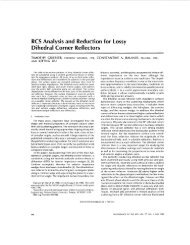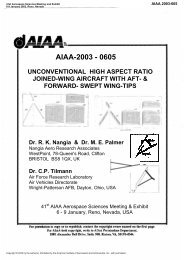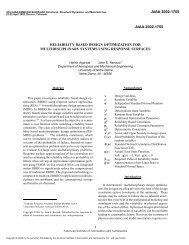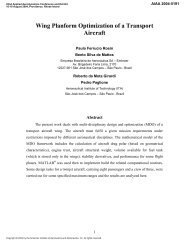Application of MDO to Large Subsonic Transport Aircraft
Application of MDO to Large Subsonic Transport Aircraft
Application of MDO to Large Subsonic Transport Aircraft
Create successful ePaper yourself
Turn your PDF publications into a flip-book with our unique Google optimized e-Paper software.
(c)2000 American Institute <strong>of</strong> Aeronautics & Astronautics or published with permission <strong>of</strong> author(s) and/or author(s)’ sponsoring organization.<br />
a) 1 Load distribution parameter p. This<br />
allowed the wing load distribution <strong>to</strong> vary<br />
from over-elliptic <strong>to</strong> under elliptic.<br />
b) 4 Wing planform parameters: Aspect ratio,<br />
Root chord, outboard taper ratio and sweep.<br />
Planform changes were performed such that<br />
the wing area remained constant.<br />
c) 2 Thickness parameters: Root thickness-<strong>to</strong>-<br />
chord ratio, Kink thickness-<strong>to</strong> chord ratio.<br />
The thickness was assumed <strong>to</strong> vary in a fixed<br />
parametric way from the root <strong>to</strong> the kink and<br />
the kink <strong>to</strong> the tip.<br />
Execution <strong>of</strong> the study<br />
With our present method we first analyzed the<br />
performance <strong>of</strong> the reference configuration. The<br />
predicted weight and drag ‘were very good.<br />
Cruise drag and weight were predicted with an<br />
error <strong>of</strong> around 2% as compared <strong>to</strong> the best<br />
available numbers for the reference<br />
configuration. The numbers were calibrated <strong>to</strong><br />
correspond exactly <strong>to</strong> the reference aircraft<br />
performance.<br />
Next, parametric scans were performed <strong>of</strong> the<br />
design parameters. The results were quite<br />
surprising. Fig. 4 showed that for the reference<br />
aircraft the aspect ratio had <strong>to</strong> be reduced from 8<br />
<strong>to</strong> 6 <strong>to</strong> achieve the minimum objective function<br />
values (wing weight + fuel weight). In this case,<br />
the objective function was only reduced by 5 <strong>to</strong>ns<br />
in absolute terms. After performing an<br />
optimization <strong>of</strong> the design parameters the scan <strong>of</strong><br />
the aspect ratio showed that the original aspect<br />
ratio was indeed the best one, but only in<br />
combination with other values for the other<br />
design parameters. This exercise again shows the<br />
dangers <strong>of</strong> relying on 1-D parametric scans <strong>to</strong><br />
drive such non-linear designs.<br />
Next a matrix <strong>of</strong> 9 scenarios, each with 9 sub-<br />
scenarios (81 cases) was investigated. The<br />
scenarios covered expected uncertainties in both<br />
the wing structural mass (as predicted by FAME)<br />
and the cruise fuel mass due <strong>to</strong> aerodynamic<br />
performance (as predicted by Globair). The<br />
combination <strong>of</strong> all these scenarios covered all<br />
expected analysis errors.<br />
Fig 5. shows the result. All optimal wings<br />
showed significant improvements with respect <strong>to</strong><br />
the reference wing. This was true even if it was<br />
assumed (in the extreme case) that both the<br />
aerodynamic and structural benefits predicted by<br />
the analysis were 20% lower in each case than<br />
computed. The (analysis = true) point shows the<br />
performance <strong>of</strong> the optimized wing assuming that<br />
the analyses were correct.<br />
The solutions that get most <strong>of</strong> their benefit out <strong>of</strong><br />
the reduction <strong>of</strong> the wing structural mass are<br />
called “structures solutions”. The solutions that<br />
get most <strong>of</strong> their benefit (in terms <strong>of</strong> the<br />
objective function) out <strong>of</strong> the reduction <strong>of</strong> the<br />
fuel weight are called “aero solutions”.<br />
Selection <strong>of</strong> the best design<br />
6<br />
American Institute for Aeronautics and Astronautics<br />
Since we felt that all scenarios were equally<br />
likely <strong>to</strong> be true, we were interested in whether<br />
we could find a design that was most likely <strong>to</strong><br />
produce good performance. We did this by<br />
identifying the range <strong>of</strong> optimal design<br />
parameters for the different scenarios. Fig. 6<br />
shows the result.<br />
This showed that for three design parameters the<br />
direction <strong>of</strong> change was irrespective <strong>of</strong> the<br />
scenario. The load parameter was changed the<br />
most. The optimal design very likely had more<br />
load on the inboard wing than the reference<br />
design. Also the sweep was increased and the<br />
root chord decreased for all designs.<br />
Fig. 7 shows why it is so important <strong>to</strong> have an<br />
inboard shifted load distribution for this type <strong>of</strong><br />
aircraft. First <strong>of</strong> all, moving the load from the<br />
outboard wing <strong>to</strong> the inboard wing reduces the<br />
wing bending moments and decreases wing<br />
weight. Secondly, the nose-up pitching moment<br />
causes a reduction in the tail down loads and<br />
therefore reduces the load on the wing required<br />
<strong>to</strong> pull 2.5 g’s Thirdly, induced drag <strong>of</strong> an<br />
inboard loaded wing + downloaded tail is not<br />
very different from the ideal induced drag. This<br />
can be easily unders<strong>to</strong>od by applying Munk’s<br />
theorem [ 121.<br />
A year before this study was completed (1997)<br />
the second author had already proposed this<br />
design modification. This was not adopted at that<br />
time because shifting the load inboard caused<br />
significant additional wave drag.


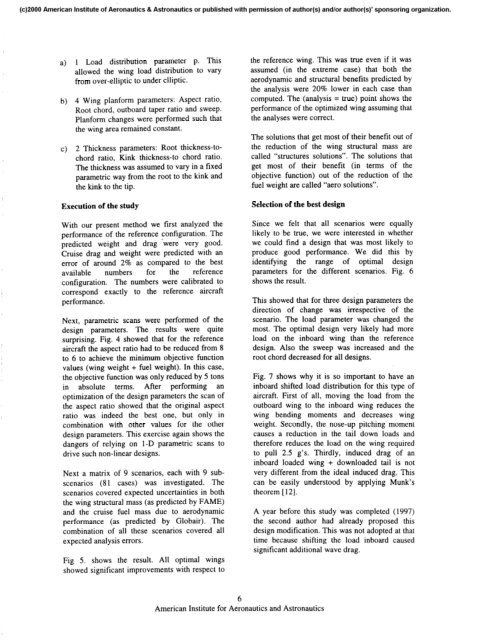





![Introduction to RF Stealth [Book Review] - Antennas and ...](https://img.yumpu.com/16857890/1/190x245/introduction-to-rf-stealth-book-review-antennas-and-.jpg?quality=85)

